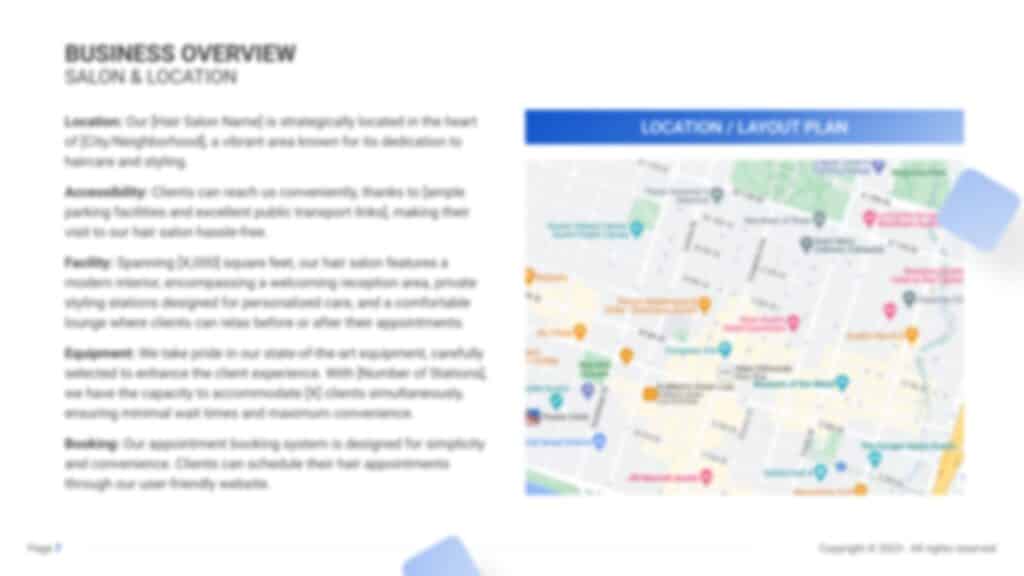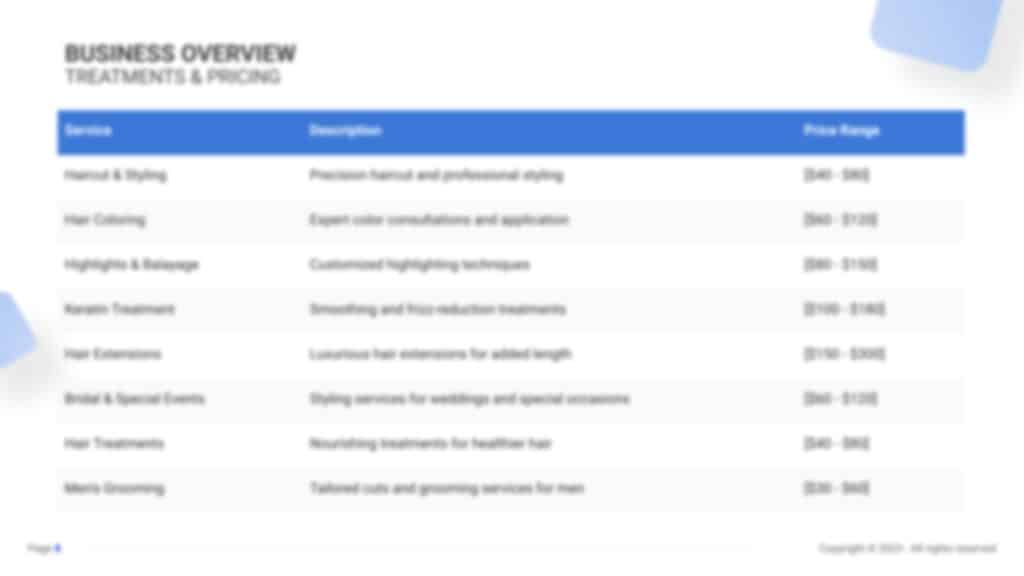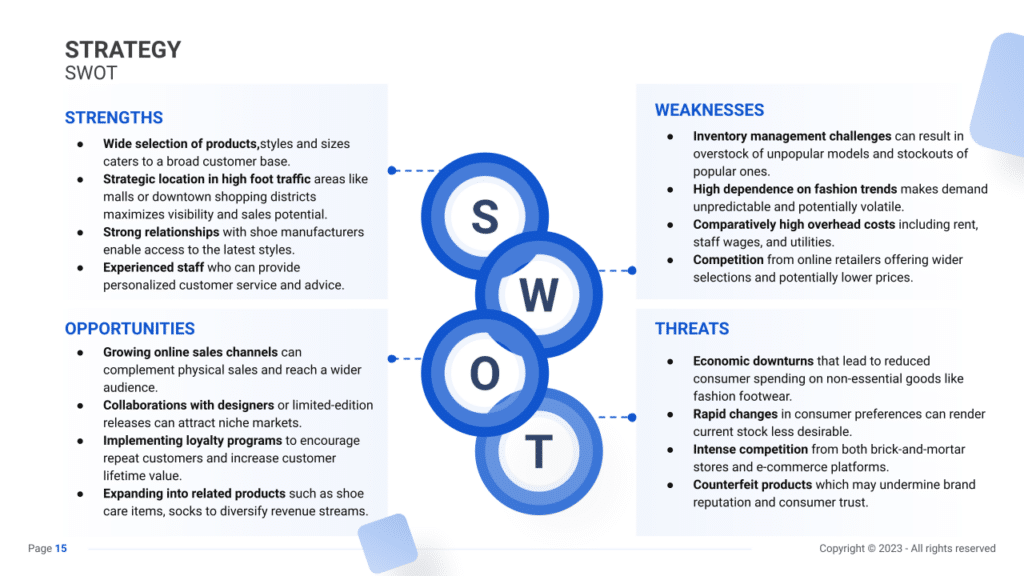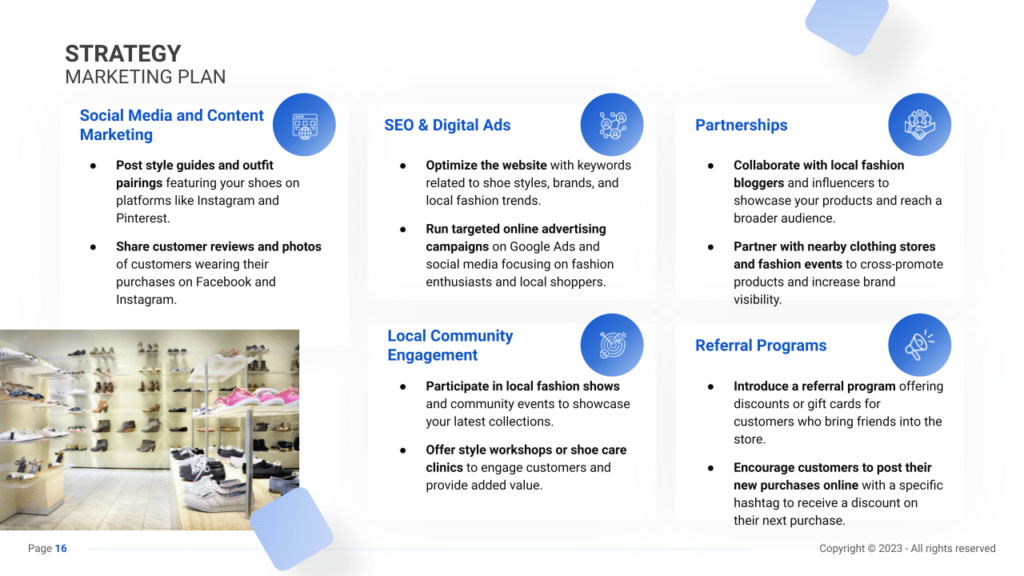Shoe Store Business Plan Template & PDF Example

Creating a comprehensive business plan is crucial for launching and running a successful shoe store. This plan serves as your roadmap, detailing your vision, operational strategies, and financial plan. It helps establish your shoe store business’s identity, navigate the competitive market, and secure funding for growth.
This article not only breaks down the critical components of a shoe store business plan, but also provides an example of a business plan to help you craft your own.
Whether you’re an experienced entrepreneur or new to the retail industry, this guide, complete with a business plan example, lays the groundwork for turning your shoe store business concept into reality. Let’s dive in!
The Plan
Our shoe store business plan is structured to cover all essential aspects needed for a comprehensive strategy. It outlines the store’s operations, marketing strategy, market environment, competitors, management team, and financial forecasts.
- Executive Summary: Offers an overview of your shoe store’s business concept, market analysis, management, and financial strategy.
- Business Overview: Provides detailed information on what your shoe store offers and its operational model:
- Store & Location: Describes the store’s design, amenities, and why its location is appealing to potential clients.
- Supply & Products: Lists the types of shoes and related products provided by your store, including pricing structure.
- Market Overview: Examines the shoe store industry landscape, identifying competitors and how your store stands out:
- Key Stats: Shares industry size, growth trends, and relevant statistics for the shoe store market.
- Key Trends: Highlights recent trends affecting the shoe sector.
- Key Competitors: Analyzes main competitors nearby and how your shoe store differs from them.
- Strategy: Outlines how the shoe store intends to achieve growth and attract clients:
- SWOT Analysis: Strengths, weaknesses, opportunities, and threats analysis.
- Marketing Plan: Strategies for attracting and retaining customers.
- Timeline: Key milestones and objectives from start-up through the first year of operation.
- Management: Information on who manages the shoe store and their roles.
- Financial Plan: Projects the store’s 5-year financial performance, including revenue, profits, and expected expenses.

Executive Summary
The Executive Summary introduces your shoe store’s business plan, offering a concise overview of your store and its services. It should detail your market positioning, the range of footwear and accessories you offer, its location, size, and an outline of day-to-day operations.
This section should also explore how your shoe store will integrate into the local market, including the number of direct competitors within the area, identifying who they are, along with your store’s unique selling points that differentiate it from these competitors.
Furthermore, you should include information about the management and co-founding team, detailing their roles and contributions to the store’s success. Additionally, a summary of your financial projections, including revenue and profits over the next five years, should be presented here to provide a clear picture of your store’s financial plan.
Shoe Store Business Plan Executive Summary Example


Business Overview
When detailing the business overview in your executive summary, it’s crucial to provide clear and concise information. This includes the name of your store, its location, and an overview of daily operations.
These details not only introduce your business but also set the stage for its unique qualities. Indeed, a unique selling proposition (USP) is what sets your store apart from the competition. Whether it’s your focus on comfort, style, and durability, or a curated selection of premium brands, your USP should be a focal point of your executive summary. It’s what captures the interest of your audience and showcases the unique value your business brings to the market.
Example:
For instance, “Foot Haven,” located in downtown Springfield, operates from a 3,000 sq. ft. space on Main Street. It offers a wide range of products including athletic footwear, casual shoes, formal wear, and children’s shoes. Their USP is the unique combination of comfort, style, and durability, ensuring that customers find the perfect shoes for any occasion.
Market Overview
Understanding and presenting the market size, growth trends, and industry dynamics are integral parts of the market analysis. This section should highlight the potential of the U.S. shoe store industry, backed by relevant data like market value and growth rates. Discussing industry trends, such as the growing demand for stylish and durable footwear, provides insight into the evolving landscape and where your store fits within it.
Equally important is the competitive landscape. Your executive summary should identify key competitors and explain how your store positions itself in this environment. Whether you focus on premium brands, exceptional customer service, or a curated selection of footwear, this is your opportunity to showcase how your store is poised to stand out in a crowded market.
Example:
Consider Foot Haven in the U.S. shoe store industry, valued at $88.5 billion with a 3.30% annual growth rate. While competing with local boutiques and national chains in Springfield, Foot Haven differentiates itself by offering premium brands such as Nike, Adidas, Clarks, and Timberland, catering to customers seeking both fashion and functionality.
Management Team
The management team’s background and expertise are significant assets to your business. In your executive summary, highlight the key qualifications and experiences of your team members.
This might include your co-founder’s extensive experience in retail management or your head buyer’s expertise in sourcing high-quality footwear. Demonstrating the team’s expertise not only builds credibility but also assures potential investors and partners of your store’s capability to succeed.
Example:
At Foot Haven, co-founders Jane Doe and John Smith lead the team. Jane, with a background in retail management, provides strategic leadership, oversees product selection, and ensures the store offers cutting-edge products that meet customer needs. John, with a background in finance and accounting, manages the company’s finances, including budgeting, financial reporting, and inventory management, ensuring financial stability and growth opportunities for the store.
Financial Plan
The financial plan overview should succinctly summarize your financial goals and projections, including revenue targets and profit margins, to provide a clear picture of your store’s financial trajectory.
Example:
Foot Haven aims for $2.3 million in annual revenue by 2028, targeting a 12% EBITDA margin. The financial strategy includes initial investments in high-quality store design and inventory, with sales growth driven by effective marketing and community engagement. We project steady growth, positioning Foot Haven as a leading footwear retailer in the local market.
Business Overview
For a Shoe Store, the Business Overview section can be concisely divided into two main slides:
Store & Location
Briefly describe the store’s physical environment, emphasizing its design, comfort, and the overall atmosphere that welcomes customers. Mention the store’s location, highlighting its accessibility and the convenience it offers to customers, such as proximity to shopping centers or ease of parking. Explain why this location is advantageous in attracting your target clientele.
Supply & Products
Detail the range of footwear and accessories offered, from casual and formal shoes to sportswear and specialized footwear. Outline your pricing strategy, ensuring it reflects the quality of products provided and matches the market you’re targeting. Highlight any exclusive brands, seasonal collections, or limited-edition items that provide added value to your customers, encouraging repeat business and customer loyalty.


Market Overview

Industry Size & Growth
In the Market Overview of your shoe store business plan, start by examining the size of the footwear industry and its growth potential. This analysis is crucial for understanding the market’s scope and identifying expansion opportunities. Highlight relevant statistics and data that demonstrate the industry’s value and projected growth rates over the next few years.
Key Market Trends
Proceed to discuss recent market trends, such as the increasing consumer interest in athleisure footwear, sustainable and ethically produced shoes, and customization options. For example, highlight the demand for footwear that caters to specific needs like orthotic support or vegan materials, alongside the rising popularity of online shopping and augmented reality (AR) try-on features.
Competitive Landscape
A competitive analysis is not just a tool for gauging the position of your shoe store in the market and its key competitors; it’s also a fundamental component of your business plan.
This analysis helps in identifying your shoe store’s unique selling points, essential for differentiating your business in a competitive market.
In addition, the competitive analysis is integral in laying a solid foundation for your business plan. By examining various operational aspects of your competitors, you gain valuable information that ensures your business plan is robust, informed, and tailored to succeed in the current market environment.
Identifying Your Competitors in the Shoe Store Industry
Identifying competitors is the first step in understanding your position in the shoe store market. Begin by mapping out local shoe stores and footwear retailers. For instance, if your store specializes in high-end fashion shoes, your direct competitors include nearby boutiques known for their premium shoes, as well as larger retail chains that offer a wide range of footwear. Don’t overlook indirect competitors such as department stores and online retailers that offer extensive shoe collections.
Use online tools like Google Maps to get a geographical sense of competitor distribution. Platforms like Yelp and TripAdvisor offer customer reviews and ratings, providing insights into competitors’ strengths and weaknesses. For example, if several reviews commend the stylish selection and customer service at “Urban Sole,” this is a key strength of your competitor.

Shoe Store Competitors’ Strategies
Analyzing the strategies of these competitors involves several aspects:
- Product Range: Examine their range of footwear. If “EcoStep” is gaining popularity with its sustainable and eco-friendly shoes, it indicates a market trend toward ethical fashion.
- Merchandising: Consider the merchandising and display techniques. A store like “Footwear Trends” that focuses on trendy, seasonal displays might attract fashion-forward customers, while “Comfort First” might appeal to those looking for practical, comfortable shoes.
- Pricing Strategy: Compare your prices with those of competitors. Are your shoes priced similarly to “Value Feet” or are they more aligned with the premium offerings at “Designer Shoes Boutique”?
- Marketing Tactics: Look at how competitors market their products. Do they have a strong social media presence, or do they rely more on loyalty programs and in-store promotions?
- Customer Experience: Assess the in-store experience. For instance, “Friendly Footwear” might be known for its personalized fitting services and knowledgeable staff, enhancing the shopping experience.
- Operational Efficiency: Observe if competitors are using technology or innovative processes to streamline shopping and purchasing, such as “Quick Step Shoes” with its online inventory check and in-store pickup options.
What’s Your Shoe Store’s Value Proposition?
Reflect on your store’s unique value proposition. Maybe your shoe store is known for its exclusive designer collaborations, or perhaps you offer a unique range of custom-fit shoes that aren’t available elsewhere in your area.
Identify market gaps through customer feedback and industry trends. For example, the growing interest in sustainable and ethically-made footwear could represent a market opportunity if competitors are not addressing this demand.
Consider your location: A shoe store in a busy urban area might focus on trendy, fast-fashion items, while a store in a suburban neighborhood could capitalize on offering a wide range of sizes and styles for families.
Strategy

SWOT
First, conduct a SWOT analysis for the shoe store, highlighting Strengths (such as a diverse product range and prime location), Weaknesses (including high operational costs or strong competition), Opportunities (for example, increasing trends in sustainable and customized footwear), and Threats (such as economic downturns that may decrease consumer spending on non-essential items).

Marketing Plan
Next, develop a marketing strategy that outlines how to attract and retain customers through targeted advertising, promotional discounts, engaging social media presence, and community involvement.
Marketing Channels
Leveraging diverse marketing channels is crucial for building brand awareness and driving foot traffic to your shoe store.
Digital Marketing
Utilize online platforms effectively:
- Social Media: Leverage social media platforms to showcase your shoe collection creatively. Engage customers with interactive content, behind-the-scenes glimpses, and influencer collaborations. Utilize platforms like Facebook and Instagram ads to reach a broader audience with targeted campaigns.
- Email Marketing: Build an email list by offering incentives or newsletters featuring style guides, exclusive offers, and updates on new arrivals.
- Website and SEO: Ensure a user-friendly website with intuitive navigation, high-quality visuals, and a seamless checkout process. Invest in Search Engine Optimization (SEO) to rank higher in search engine results for relevant shoe-related keywords, enhancing online visibility.
Local Advertising
Connect with the local community:
- Flyers and Local Print: Distribute well-designed flyers in strategic locations, advertise in local magazines, and collaborate with local influencers to reach a wider audience.
- Community Engagement: Participate in community events, sponsor local sports teams, or organize shoe drives for charity to foster community relations.
- Partnerships: Collaborate with complementary businesses like clothing boutiques or wellness centers for joint promotions or co-marketing initiatives.
Promotional Activities
Engage customers with enticing offers:
- Special Deals: Introduce seasonal promotions like ‘Back-to-School Shoe Sale’ or ‘Holiday Footwear Discounts’ to attract customers. Offer first-time visitors discounts to encourage trial purchases.
- Loyalty Programs: Implement loyalty cards or digital programs where customers earn points for purchases, redeemable for discounts or exclusive merchandise.
- Referral Incentives: Provide incentives for customers who refer friends or family to your store, such as discounts or exclusive access to limited editions.

Sales Channels
Maximizing revenue through various sales strategies is essential for sustainable growth.
In-Store Upselling
Maximize sales during customer visits:
- Accessorize and Bundles: Suggest complementary products like socks, insoles, or shoe care kits at the point of sale. Offer bundled discounts for multiple purchases.
- Personalized Recommendations: Train staff to provide personalized recommendations based on customer preferences, enhancing the shopping experience.
Online Sales and Services
Leverage digital tools for streamlined sales:
- E-Commerce Integration: Implement an intuitive online store for seamless purchasing. Offer online-exclusive discounts or promotions.
- Virtual Try-On or Fitting Tools: Provide virtual fitting options to enhance the online shopping experience, reducing returns and improving customer satisfaction.
Membership and Loyalty Programs
Encourage repeat purchases:
- Membership Benefits: Offer subscription-based programs providing early access to sales, exclusive collections, or free shipping.
- Tiered Loyalty Rewards: Develop a loyalty program with tiered benefits based on customer spending, rewarding top-tier members with VIP services or personalized discounts.
Strategy Timeline
Finally, create a detailed timeline that outlines critical milestones for the shoe store’s opening, marketing efforts, customer base growth, and expansion objectives, ensuring the business moves forward with clear direction and purpose.

Management
The Management section focuses on the shoe store business’s management and their direct roles in daily operations and strategic direction. This part is crucial for understanding who is responsible for making key decisions and driving the shoe store toward its financial and operational goals.
For your shoe store business plan, list the core team members, their specific responsibilities, and how their expertise supports the business.


Financial Plan
The Financial Plan section is a comprehensive analysis of your financial projections for revenue, expenses, and profitability. It lays out your shoe store business’s approach to securing funding, managing cash flow, and achieving breakeven.
This section typically includes detailed forecasts for the first 5 years of operation, highlighting expected revenue, operating costs and capital expenditures.
For your shoe store business plan, provide a snapshot of your financial statement (profit and loss, balance sheet, cash flow statement), as well as your key assumptions (e.g. number of customers and prices, expenses, etc.).
Make sure to cover here
_ Profit and Loss
_ Cash Flow Statement
_ Balance Sheet
_ Use of Funds









